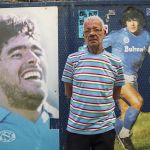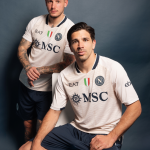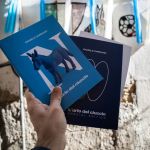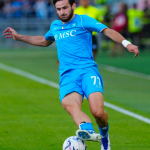
Maradona, Napoli and English fashion
A chat with the founder of TRiCKETT England who takes inspiration from the colors of Napoli and Naples
June 29th, 2020
When you look at TRiCKETT England products, you immediately feel that there is one of those stories behind that deserve to be told. After all, great lovers of Naples and Napoli in Accrington, in the county of Lancashire, are not many. Yet Iain Trickett - founder of the British fashion brand - was struck by the road that leads to Stadio San Paolo, the Riviera di Chiaia and the Quartieri Spagnoli. Trickett's works are clearly inspired by the Neapolitan culture, the colors of Naples and the stories that make the city "intoxicating". We asked Iain to tell us about his love story with Naples, his relationship with fashion and his latest work, the photographic book "This is Naples" to be released on July 2nd.
You have always claimed to be fascinated by the different sports cultures that often become sources of inspiration. Where did your “obsession” with the city Naples and Napoli begin? And why Naples?
I think sport triggers something in many of us, the thrill of victory, the agony of defeat and everything in between. I have always found the places and communities that make sport a part of their daily lives the most attractive and I think this is why I love Napoli as much as I do.
The first time I visited Sorrento, I was struck by how a town 40km away from Napoli could be as obsessed with the team as people in the centre of the city. I would walk around and old men would have wallets with the famous Napoli N on them. There were pictures of Maradona all around, jerseys from seasons passed and all in what is basically a tourist trap.
After that I just made it my mission to find out why people loved Napoli as much as they did. I am still, to this day, amazed by what I find and what people say about the place. The personalities, the culture, the football team, religion, art, music - it is intoxicating. As Pino Daniele said “Napoli is a thousand colours” and I want to see every single one of them.
In addition to the sporting cultures that inspire your approach to style, you often mentioned vintage photography. How do you manage to transform what you see into a photo of the past into the items you produce?
Without sounding like someone’s grandparent, things were just made better back in the day. From sportswear to suits, refrigerators to cars, tools to houses, there was a pride in making something that would last a long time and making it to the very best of your ability. I have sweatshirts from the ‘80s and ‘90s that I wear more than ones from last year, purely because of how they are made.
Photography captures a moment in time and whether that is a beautiful 1950’s American high school football game or an amateur photograph that my parents took, I will study it and see what is being worn and how it is being worn. My mother and father have always been into trainers and sportswear, so I would look at the photographs with them and ask where they purchased the item and where it was made. I was very lucky that they could remember how it felt and what material it was made from.
With this knowledge I would then contact factories that made similar garments. I would always try to speak to the person that has been at the factory for the longest as they would be able to remember the old styles and how they were made. So really, I rely heavily on a combination of other people’s knowledge and my obsession with details!
Naples' and Napoli's colors are almost part of your DNA or at least in the DNA of the things you create. Is there an element of Neapolitan culture (which includes everything, sport, cuisine, landscapes, Mediterranean aesthetics) that you feel you are putting forward to others in terms of importance? Or in general, one you choose.
I think Italy has a very specific aesthetic and that is what I would like to think I reflect in what I do. I grew up loving brands like Stone Island, C.P Company, Gucci and I always wanted to replicate a bit of that attitude in what I do.
Napoli has an attitude that is all of its own and once you study it closely and invest in what makes the city tick it is easy to pay homage. I think the most important look that I promote is one of colour and excitement. Napoli is filled with objects and colour that we here in the UK never see, whether that is an oliera, a religious statue, graffiti or scooters constantly roaring past you. I want people to feel an element of surprise, that they are part of a club that is truly unique. In a world when you can get anything on next day delivery or through a phone screen, being genuinely surprised is something both exciting and rare these days.
Tell us about your stylistic journey. What were the steps that led you to be what you are today and to produce what you produce today?
Clothing has been a big part of my life for as long as I can remember. My mum is really into fashion and she owns some of the first pieces that Vivienne Westwood ever released. She’s also really knowledgeable about working class subcultures and in most of the images I see of her when she was young, she’s wearing something that was very ‘of the moment’. My dad was a textile merchant and is also sport fanatic. Like me, he is also particularly interested in the kits. Whether it was American football or ‘proper’ football he and I would always discuss kits and what made them special… and we still do. There is also an amazing story about how in 1994 he bought me an illuminous yellow Borussia Dortmund kit by sending a fax to the club shop in Germany. There’s also another story where he got a Paolo Maldini t-shirt by writing to Nike HQ. Good days before the internet haha.
As a teenager, I became obsessed with hip-hop - the music, the art, the culture, clothing and trainers. I just wanted to know everything and I think I got pretty close! Whether that was importing US magazines or writing emails to shops in Los Angeles with @aol.com addresses, I just wanted to know as much as I could. I relentlessly searched for items that no-one else had or understood, which led me into streetwear like the Hundreds, Supreme, Crooks and Castles. Then once those brands started becoming known, I searched even harder, going for small Japanese labels and Canadian work boot manufacturers. I just wanted to know the story and why something was important. Then came TRiCKETT, but that is a much longer story!
In one of your interviews you said that the main objective of TRiCKETT England is to "preserve a piece of sporting heritage". How do you think the sporting legacy/heritage you refer to is being lost? How can style and sport find inspiration from the past?
First and foremost, sport is a business and when it comes to the on and off-field garments, they know how to make money. The sportswear manufacturers understand how it all works and that is why they constantly pump out the same shoe or jersey in 100 colours. But I think there is something really special in having something that was around for a short time and then never repeated.
All you have to do is look at how well the retro football shirt market works. People want something that they couldn’t have at the time, or weren’t old enough to understand, or couldn’t afford. I think that there is magic in remembering things and listening to stories from people who were there. Sure, it may not be as accurate as a Google image search, but when I want to preserve a piece of sporting heritage, I aim to maintain the mystery. I want people to be excited about doing something, engaging with something and enjoying something. For me that is what gets me up in the morning - to be excited. I hope TRiCKETT can capture a little bit of that.
Naples is close to your job but it is still 2,400 km away from your Accrington. Have you ever been to San Paolo? Have you ever had the opportunity to live a day together with real Naples, retracing the routine of a Napoli fan?
PS: who is your player symbol of Napoli now?
I am very lucky that I have some amazing friends in Napoli and that I get to visit often. I think to understand a place you have to visit and to truly understand Napoli, you have to live it and that is what I try to do. My friends send me pictures of life there every single day and I feel pretty connected, sure it isn’t Accrington, but having a little bit of escapism from East Lancashire is never a bad thing.
I have been to the stadium a few times and it still amazes me that this is where Maradona played his best football. I also think that Neapolitans are some of the most technical football fans I have ever met. The game is more important than the individuals. The team is the city and therefore the people in the stands. The fans just want to see the city portrayed in the best possible way on the pitch - winning is great, but successfully representing the city and the shirt is far more important. I feel that this is unique to Napoli.
To answer your P.S. I think it has to be Lorenzo Insigne. He is Neapolitan, plays at a disadvantage due to his height, sometimes plays too hard, but he always seems to want to do the best he can and I feel that is all Napoli ever wants. I can’t imagine what an honour it must be to be Neapolitan and the captain of the club.
You said that the figure that most influenced your stylistic direction is Michael Jordan. In your works, however, the most common sporting character is Maradona. Can such strong personalities from the world of sport be compared stylistically?
Growing up and being amazed on a daily basis by what Michael Jordan did on the court and what he did for trainer culture pretty much cements him as my all-time style influence. I think a close second is Allen Iverson, but let’s not get into that now!
Diego Maradona is an icon, whether you like him or loathe him. Without Maradona I am not sure if football culture, as we know it today, would exist. He had a pretty adventurous time off the pitch and on the pitch there was no doubt that he was one of, if not the, most talented players ever to kick a ball. Both MJ and D10S are probably two of the worst dressed people in the world of sport, but how they carry themselves and their confidence are what make them iconic and this is how I like to reference them in my designs.
Great clothing and design should always be about confidence, interest and ultimately making you feel good. Diego and Michael always brought these things to their performances and I just hope I replicate it to a small degree through the TRiCKETT shop.
Let's talk about "This is Naples", the photographic book released on July 2 that tells a sacred place in Naples like the Spanish Quarters and the characters who inhabit them. What do places, people and artistic panoramas of that area of Naples have for you?
The Spanish Quarter has a reputation for being a dangerous, mysterious place that you would only go to if you knew a lot about Napoli or someone could get in you without being mugged or murdered. However the reality is that it is a vibrant, colourful and beautiful place filled with amazing people and sights. As recently as 2 days ago I had a customer email asking if it was safe for tourists to go to Napoli, which I still find really shocking. The book was created to show Napoli in all of its glory, to encourage people to go and see the beauty of the city and the surrounding areas.
Napoli is the only places outside of my hometown of Accrington where my soul has felt at home. The two places couldn’t be more different, but the core beliefs of the two places are almost exactly the same - identity, family and working hard. I always seem to be attracted to places that don’t bend to the fashions of the time and stay very much true to themselves. Gentrification is something that is sweeping across the world and for the most part Napoli seems to be resisting it, which is yet another reason that I love the place, it stays true to itself.
I admit that a city in the shadow of a volcano is not necessarily for everyone, but when I was looking for somewhere to call home, Napoli welcomed me, made coffee, gave me their football team and asked for nothing in return. Money from the sale of the books will also go to local charities in Napoli which range from maintaining street artworks through to community projects in Rione Sanita, just as a small way of giving back to Napoli. I will always be grateful for what the sons and daughters of Vesuvius have given me and I just hope the book gives them some idea of how much they mean to me. Forza Napoli sempre.


















































